Family : Pomacentridae

Text © Giuseppe Mazza

English translation by Mario Beltramini
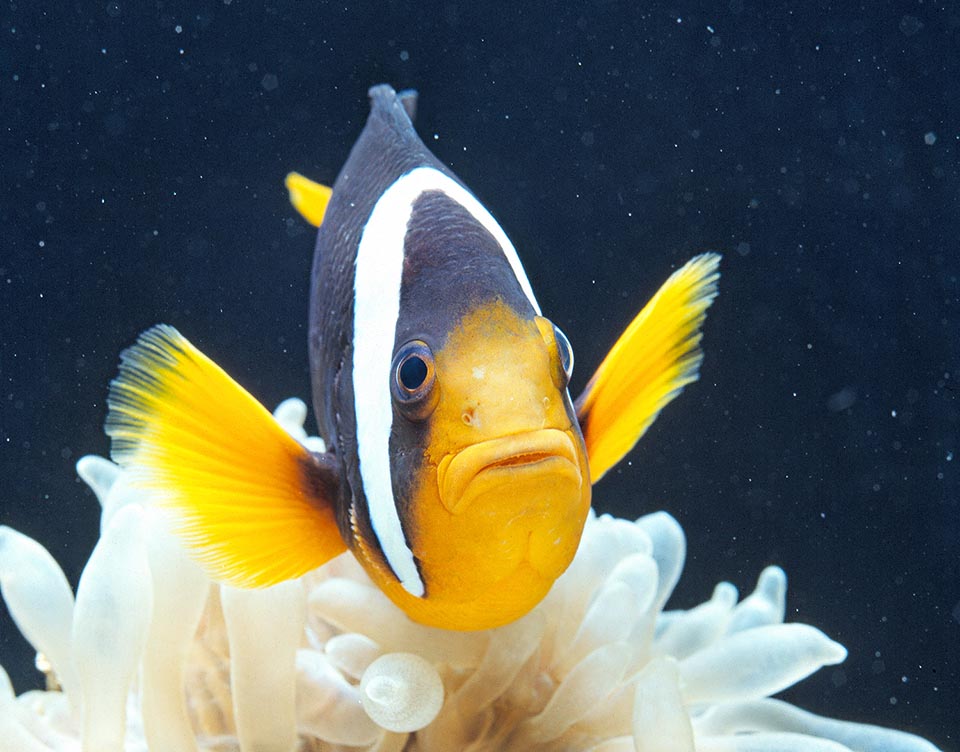
Amphiprion clarkii has a very vast range in the tropical waters of the Indian Ocean and of the western Pacific up to the Tonga archipelago © Giuseppe Mazza
The Yellowtail clownfish (Amphiprion clarkii Bennett, 1830) belongs to the class of the Actinopterygii, the ray-finned fishes, to the order of Perciformes, to the family of Pomacentridae and to the subfamily of the clownfishes, the Amphiprioninae.
The name of the genus Amphiprion comes from the Greek “amphi” = “on both sides” and “priön” = saw, because on both sides of the head the preoperculum and the suboperculum show an indent shaped like a saw.
The name of the species clarkii honours the memory of the engraver John Clark, who helped Bennett with the drawings of his book about the fishes found on the coast of Ceylon.
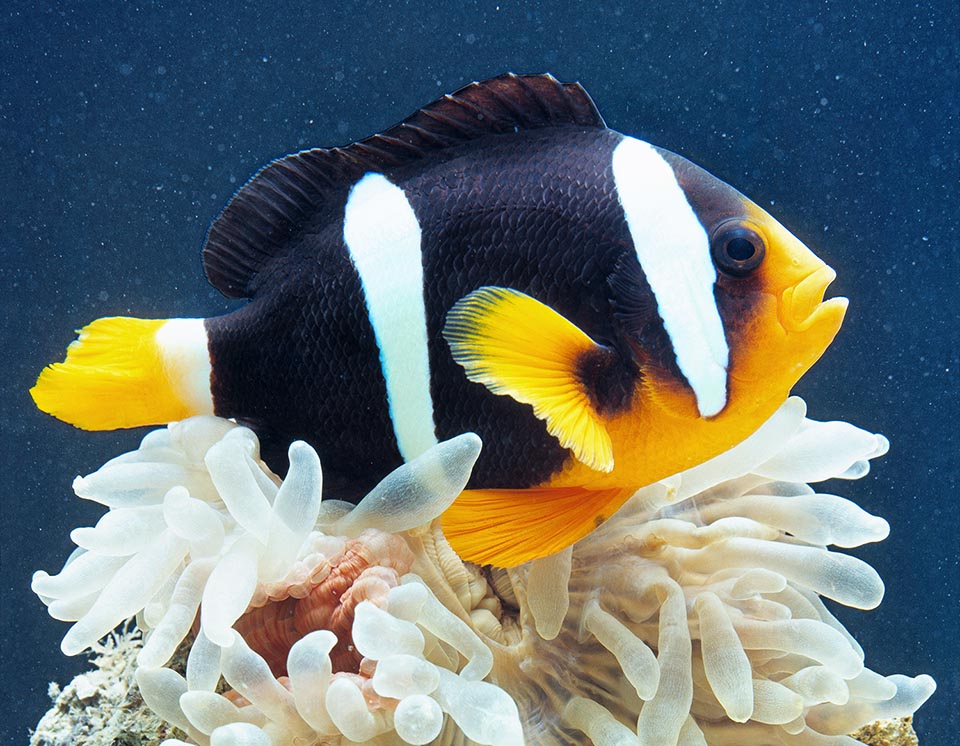
It is associated to 10 species of sea anemones, and this explains its success in captivity because it’s easy to find a host for it © Giuseppe Mazza
Zoogeography
It lives the tropical waters of the Indo-Pacific. It is present, indicatively, from Tanzania to the Persian Gulf, to Mauritius and the Maldives, in Sri Lanka, to the Andaman Islands, in Thailand, Australia, Indonesia, New Guinea, Micronesia, Philippines, Taiwan and in China up to southern Japan. In the southern hemisphere it reaches Tonga and New Caledonia.
Ecology-Habitat
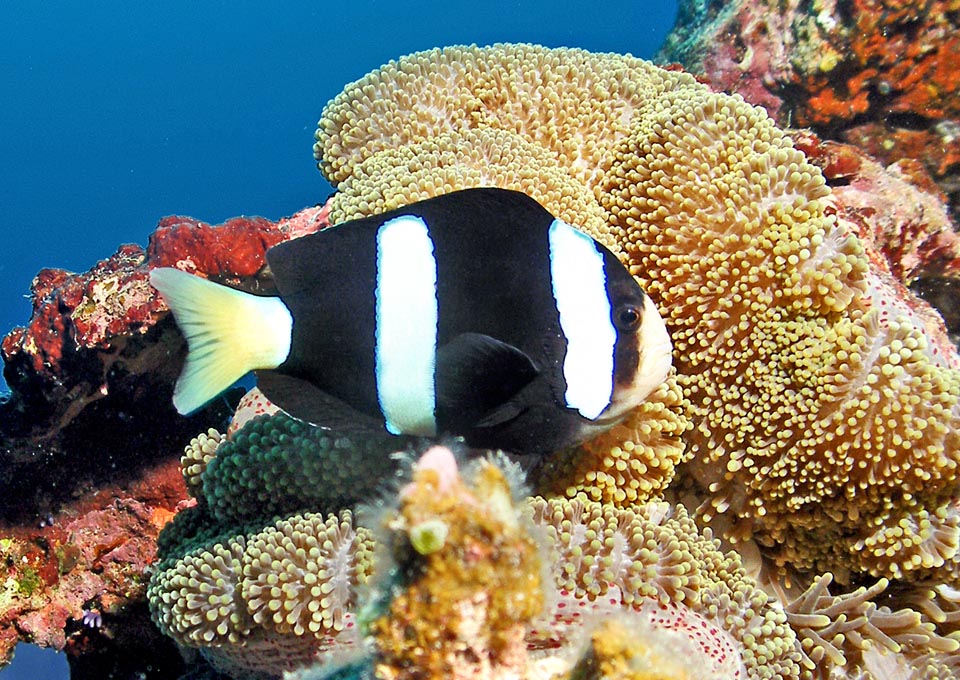
It nourishes of algae, zooplankton and edible animal fragments passing by, without going too far from the stinging tentacles that protect its actinia © Klaus Stiefel
It lives between the 50-60 m of depth, where the several symbiont actinias do fix. Not at all difficult in choosing, beats all records living among the welcoming urticant tentacles of even 10 species: the Cryptodendrum adhaesivum, the Entacmaea quadricolor, the Heteractis aurora, the Heteractis crispa, the Heteractis magnifica, the Heteractis malu, the Macrodactyla doreensis, the Stichodactyla gigantea, the Stichodactyla haddoni and the Stichodactyla mertensii.
Morpho-physiology
Of large size for a clownfish, it reaches 13-15 cm in length with a flat and tall body, like Amphiprion ephippium or Amphiprion rubrocinctus.
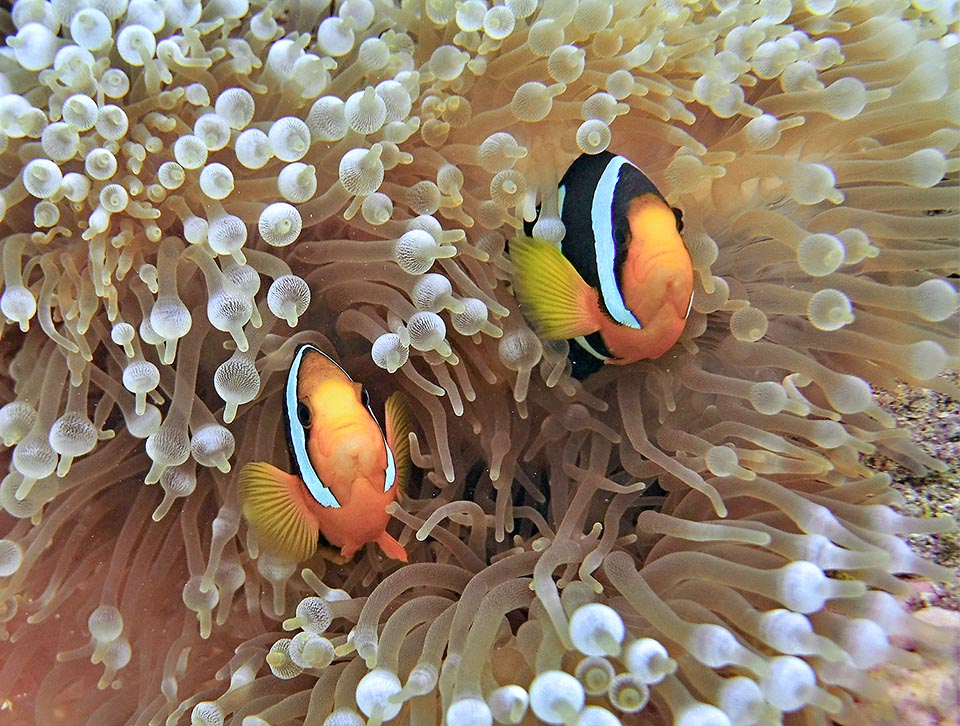
A couple on the doorstep. The alpha female is the biggest and accepts in addition to its partner also other males. If she dies the biggest one changes of sex and replaces her © Karine Marangon
The dorsal fin, unique as in all clownfishes, has 10 spiny rays plus 15-16 soft, the anal 2 spiny rays and 13-14 soft, whilst the pectoral ones, ample and roundish, count 19-20 unarmed rays. The ventral fins are more or less rounded, like the lobes of the caudal, tendentially crescent-shaped.
The livery, rather variable on the geographic level, is brown-orange on the snout, the belly and the fins, but the dorsal mostly almost black as the remainder of the body. In any case are evident three white vertical bands interesting also the back, breaking the contour of the fish. The first is at level of the operculum, close to the eye, the second at the beginning of the soft rays of the dorsal and the third one on the caudal peduncle. The caudal fin can be yellow-orange or white.
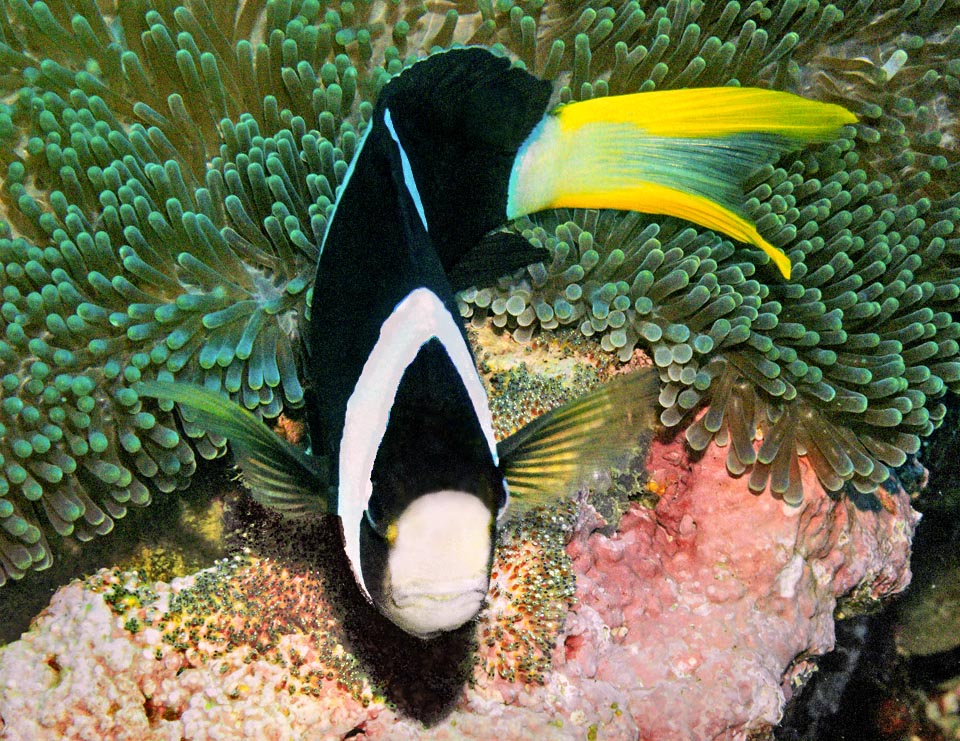
The eggs are glued to the feet of the anemone. The male fecundates and surveys them, aerating them with the fins until they hatch © Klaus Stiefel
Ethology-Reproductive Biology
The Amphiprion clarkii nourishes of algae, zooplankton and of the fragments of edible animas passing close to him.
As we have seen, it lives in symbiosis with various species of actinias with urticant tentacles, lethal for other fishes, but to which it gets accustomed since young thanks to the protective mucus covering its scales. In this way it finds a sure shelter for hiding in case of danger, and in exchange it eliminates the leftover food and the parasites of the host, chasing away the fishes that nibble its tentacles.
The yellowtail clownfish is a protandric hermaphrodite species, the males, while growing, can therefore transform into females.
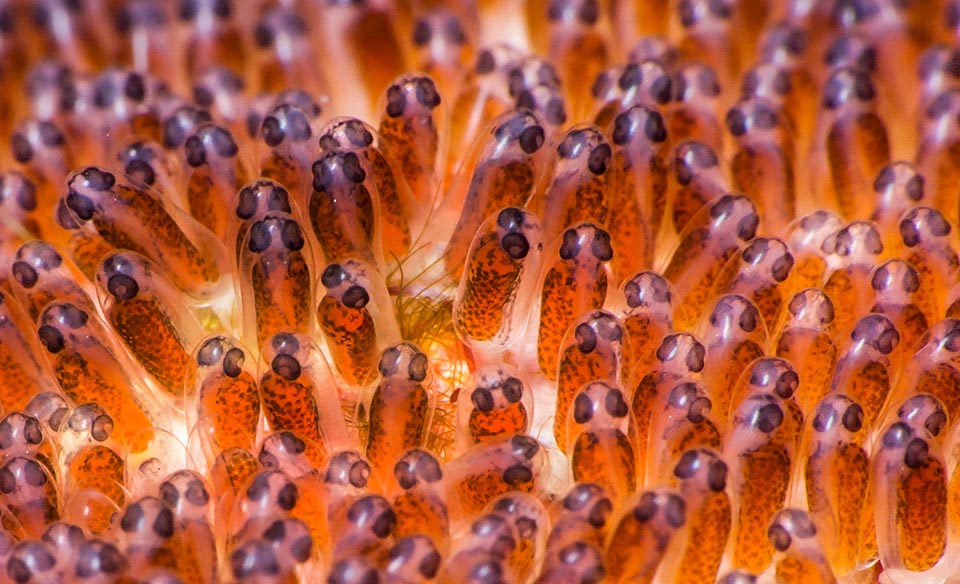
Eggs with growing larvae. As soon as born they have pelagic life, and when the last larval stage young will look for an actinia without fishes or with a hospitable mistress © Brian Cole
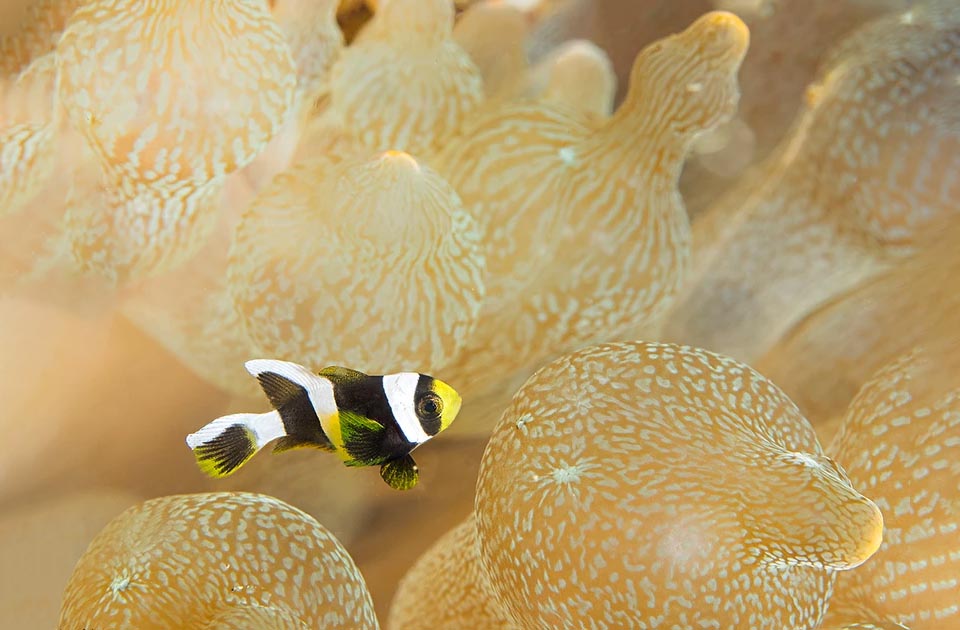
Here a small juvenile exploring prudently the poisonous tentacles of its future home © Rafi Amar
Usually a small community lives in an actinia having adequate size. The dominant female is evident at once, bigger and braver, followed in the hierarchy by the spouse and various smaller males.
When the queen dies, in a few weeks the surviving spouse becomes female and gets married with the biggest male of the group, whilst the others advance of a step in the social ladder.
In nature, the eggs are stuck at the feet of the actinia, on the rock. The male fecundates them and surveys them, ventilating them with the fins until the hatching comes, and the newborn larvae are dispersed by the currents.
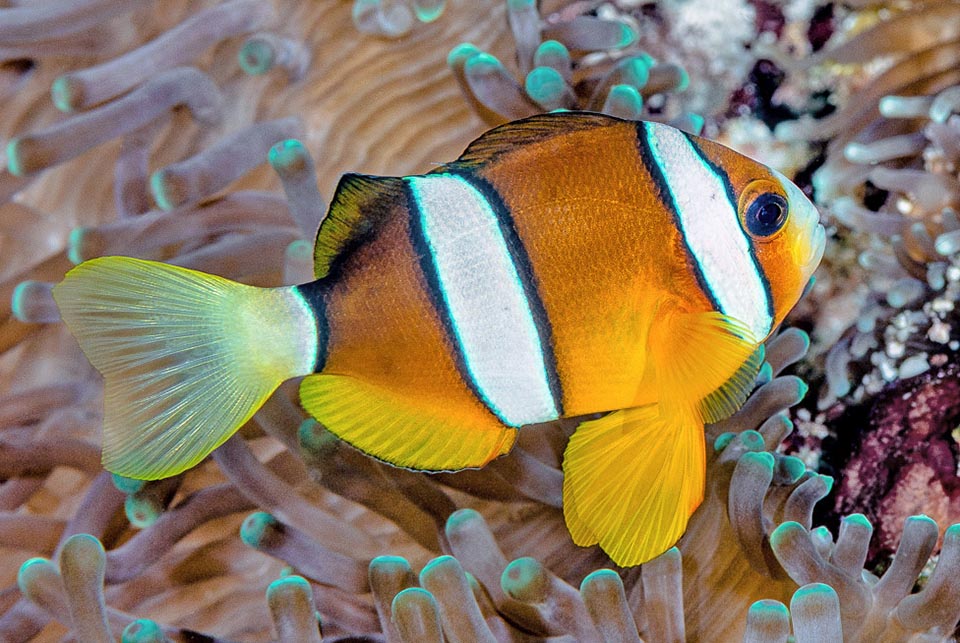
Subadult. Amphiprion clarkii is not an endangered species. If well-kept reproduces in aquarium and can live even 10 years © François Libert
If well kept, the yellowtail clownfish may reproduce in aquarium and may live even a decade. In nature the populations need 1,4-4,4 years for doubling their number and the fishing vulnerability index of the species is fairly low, at the level 29 on a scale of 100.
Synonyms
Amphiprion boholensis Cartier, 1874; Amphiprion japonicus Temminck & Schlegel, 1843; Amphiprion melanostolus Richardson, 1842; Amphiprion papuensis Macleay, 1883; Amphiprion snyderi Ishikawa, 1904; Amphiprion xanthurus Cuvier, 1830; Anthias clarkii Bennett, 1830; Sparus milii Bory de Saint-Vincent, 1831.
→ For general information about fishes please click here.
